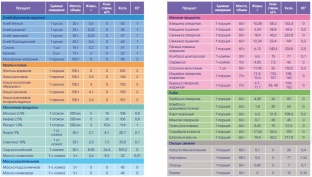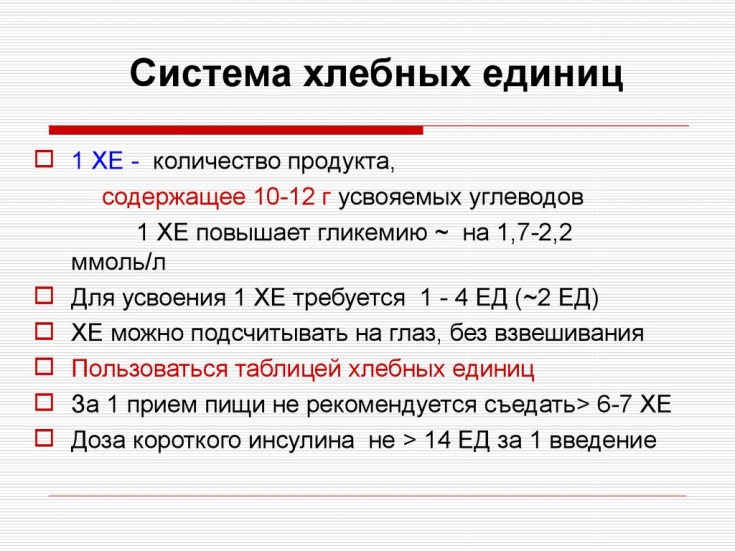Diabetes mellitus – one of the most dangerous chronic diseases, which, if not adequately treated, can lead to dangerous complications that threaten the life of the patient. This disease is characterized by a violation of carbohydrate metabolism, which in turn leads to an increase in the level of glucose in the blood and, accordingly, in the urine.
These changes entail a whole cascade of disorders, including protein and fat metabolism, water-salt imbalance.
The most important task of a diabetic – control the diet in accordance with the needs of the body, this is where bread units help with diabetes. What is it and how they are counted in food products, read in the article prepared by our portal.
Diabetes control: what are bread units and why count them
A detailed diabetes nutrition plan is prepared by a physician who takes into account a number of important factors, including type, course of disease, age, sex, weight, presence or absence of comorbidities, and level of physical activity.
Since it is important to control diabetes to calculate the amount of carbohydrates consumed in order to determine the daily dose of insulin needed by the patient, German nutritionists introduced the term bread unit (XE) – conventional unit for calculating the approximate content of carbohydrates in food.
For the convenience of diabetics, tables have been created that display the amount of XE in various food groups:
- dairy;
- bakery;
- cereals;
- potatoes and pasta;
- confectionery;
- fruit;
- vegetables;
- legumes;
- nuts;
- dried fruits;
- drinks;
- ready meals.
For the convenience of diabetics, tables have been created that display the amount of XE in various food groups.
Below estet-portal.com will tell you more:
- how to calculate XE;
- how many XE can be consumed per day.

Calculation for diabetes: why and how is the calculation of bread units
As you know, the composition of food products includes carbohydrates (the main source of energy), and proteins (the main "building material of the body", and fats, and vitamins, and minerals, and water. All of these nutrients are essential for the body to function properly, but the inability to properly utilize carbohydrate-derived glucose in diabetes necessitates careful control of the intake of these nutrients, which is what bread units are used for.
The main purpose of calculating bread units – determining the dose of insulin needed to normalize blood sugar after a meal. There is a direct relationship between the amount of carbohydrates consumed and the amount of insulin that will need to be administered afterwards.
Important information: eating 1 bread unit leads to an increase in blood sugar by 1.5 & ndash; 1.9 mmol / l.
1 bread unit equals about 10–12 g of carbohydrates.
It takes 1.4 units of short-acting insulin to metabolize 1 XE.
It is worth noting that there are many special calculators on the Internet that make the life of diabetics much easier, as they allow you to easily calculate the necessary values.
It is not difficult to calculate the XE in the finished product: for this you need to familiarize yourself with the information on its packaging, where the amount of carbohydrates, as a rule, is indicated per 100 g. This amount must be divided by 12 (1 XE), and the resulting value multiplied by product weight.
To determine the amount of XE in home-cooked dishes, you must use the table.


Acceptable daily amount of bread units for diabetes
The recommended and limiting amounts of XE per day for each person are determined by the doctor, based on body weight, activity, age and sex of the diabetic. On average, daily allowances in XE are as follows:
- At normal weight:
- sedentary lifestyle – maximum 15 bread units;
- sedentary job – maximum 18 bread units;
- average level of physical activity – maximum 25 bread units;
- high level of physical activity – maximum 30 bread units.
- If overweight:
- sedentary lifestyle – maximum 10 bread units;
- sedentary job – maximum 13 bread units;
- average level of physical activity – maximum 17 bread units;
- high level of physical activity – maximum 25 bread units.
It is important to remember that diabetes – a disease that requires discipline on the part of the patient: strict adherence to the recommendations of the attending physician, monitoring blood sugar levels, proper nutrition, the level of physical activity determined on an individual basis by a doctor.
Such an integrated approach will help not only effectively control diabetes, but also minimize the risk of heart attacks, strokes and other dangerous complications of the disease.






Add a comment